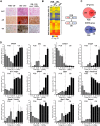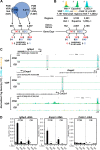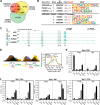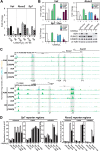Genomic determinants of gene regulation by 1,25-dihydroxyvitamin D3 during osteoblast-lineage cell differentiation
- PMID: 24891508
- PMCID: PMC4094065
- DOI: 10.1074/jbc.M114.578104
Genomic determinants of gene regulation by 1,25-dihydroxyvitamin D3 during osteoblast-lineage cell differentiation
Abstract
The biological effects of 1α,25-dihydroxyvitamin D3 (1,25 (OH)2D3) on osteoblast differentiation and function differ significantly depending upon the cellular state of maturation. To explore this phenomenon mechanistically, we examined the impact of 1,25(OH)2D3 on the transcriptomes of both pre-osteoblastic (POBs) and differentiated osteoblastic (OBs) MC3T3-E1 cells, and assessed localization of the vitamin D receptor (VDR) at sites of action on a genome-scale using ChIP sequence analysis. We observed that the 1,25(OH)2D3-induced transcriptomes of POBs and OBs were quantitatively and qualitatively different, supporting not only the altered biology observed but the potential for a change in VDR interaction at the genome as well. This idea was confirmed through discovery that VDR cistromes in POBs and OBs were also strikingly different. Depletion of VDR-binding sites in OBs, due in part to reduced VDR expression, was the likely cause of the loss of VDR-target gene interaction. Continued novel regulation by 1,25(OH)2D3, however, suggested that factors in addition to the VDR might also be involved. Accordingly, we show that transcriptomic modifications are also accompanied by changes in genome binding of the master osteoblast regulator RUNX2 and the chromatin remodeler CCAAT/enhancer-binding protein β. Importantly, genome occupancy was also highlighted by the presence of epigenetic enhancer signatures that were selectively changed in response to both differentiation and 1,25(OH)2D3. The impact of VDR, RUNX2, and C/EBPβ on osteoblast differentiation is exemplified by their actions at the Runx2 and Sp7 gene loci. We conclude that each of these mechanisms may contribute to the diverse actions of 1,25(OH)2D3 on differentiating osteoblasts.
Keywords: CCAAT/Enhancer-binding Protein (C/EBP); ChIP-sequencing (ChIP-seq); Chromatin Modification; Osteoblast; Transcription Enhancer; Vitamin D.
© 2014 by The American Society for Biochemistry and Molecular Biology, Inc.
Figures







Similar articles
-
Selective Distal Enhancer Control of the Mmp13 Gene Identified through Clustered Regularly Interspaced Short Palindromic Repeat (CRISPR) Genomic Deletions.J Biol Chem. 2015 Apr 24;290(17):11093-107. doi: 10.1074/jbc.M115.648394. Epub 2015 Mar 15. J Biol Chem. 2015. PMID: 25773540 Free PMC article.
-
Selective regulation of Mmp13 by 1,25(OH)2D3, PTH, and Osterix through distal enhancers.J Steroid Biochem Mol Biol. 2016 Nov;164:258-264. doi: 10.1016/j.jsbmb.2015.09.001. Epub 2015 Sep 5. J Steroid Biochem Mol Biol. 2016. PMID: 26348136 Free PMC article.
-
1,25-Dihydroxyvitamin D3 stimulates cyclic vitamin D receptor/retinoid X receptor DNA-binding, co-activator recruitment, and histone acetylation in intact osteoblasts.J Bone Miner Res. 2005 Feb;20(2):305-17. doi: 10.1359/JBMR.041112. Epub 2004 Nov 16. J Bone Miner Res. 2005. PMID: 15647825
-
Genomic mechanisms involved in the pleiotropic actions of 1,25-dihydroxyvitamin D3.Biochem J. 1996 Jun 1;316 ( Pt 2)(Pt 2):361-71. doi: 10.1042/bj3160361. Biochem J. 1996. PMID: 8687373 Free PMC article. Review.
-
Epigenetic histone modifications and master regulators as determinants of context dependent nuclear receptor activity in bone cells.Bone. 2015 Dec;81:757-764. doi: 10.1016/j.bone.2015.03.012. Epub 2015 Mar 27. Bone. 2015. PMID: 25819039 Free PMC article. Review.
Cited by
-
CCAAT/enhancer-binding protein beta (C/EBPβ) is an important mediator of 1,25 dihydroxyvitamin D3 (1,25D3)-induced receptor activator of nuclear factor kappa-B ligand (RANKL) expression in osteoblasts.BMB Rep. 2019 Jun;52(6):391-396. doi: 10.5483/BMBRep.2019.52.6.166. BMB Rep. 2019. PMID: 30355436 Free PMC article.
-
Expression of nephronectin is enhanced by 1α,25-dihydroxyvitamin D3.FEBS Open Bio. 2016 Jul 13;6(9):914-8. doi: 10.1002/2211-5463.12085. eCollection 2016 Sep. FEBS Open Bio. 2016. PMID: 27642554 Free PMC article.
-
Vitamin K and D Supplementation and Bone Health in Chronic Kidney Disease-Apart or Together?Nutrients. 2021 Mar 1;13(3):809. doi: 10.3390/nu13030809. Nutrients. 2021. PMID: 33804453 Free PMC article. Review.
-
Epigenetic regulation of bone cells.Connect Tissue Res. 2017 Jan;58(1):76-89. doi: 10.1080/03008207.2016.1177037. Epub 2016 Apr 14. Connect Tissue Res. 2017. PMID: 27082893 Free PMC article. Review.
-
Neuropilin 2 in osteoblasts regulates trabecular bone mass in male mice.Front Endocrinol (Lausanne). 2023 Aug 1;14:1223021. doi: 10.3389/fendo.2023.1223021. eCollection 2023. Front Endocrinol (Lausanne). 2023. PMID: 37600714 Free PMC article.
References
-
- Lieben L., Carmeliet G., Masuyama R. (2011) Calcemic actions of vitamin D: effects on the intestine, kidney and bone. Best Pract. Res. Clin. Endocrinol. Metab. 25, 561–572 - PubMed
-
- Plum L. A., DeLuca H. F. (2010) Vitamin D, disease and therapeutic opportunities. Nat. Rev. Drug Discov. 9, 941–955 - PubMed
-
- Lacey D. L., Timms E., Tan H. L., Kelley M. J., Dunstan C. R., Burgess T., Elliott R., Colombero A., Elliott G., Scully S., Hsu H., Sullivan J., Hawkins N., Davy E., Capparelli C., Eli A., Qian Y. X., Kaufman S., Sarosi I., Shalhoub V., Senaldi G., Guo J., Delaney J., Boyle W. J. (1998) Osteoprotegerin ligand is a cytokine that regulates osteoclast differentiation and activation. Cell 93, 165–176 - PubMed
Publication types
MeSH terms
Substances
Grants and funding
LinkOut - more resources
Full Text Sources
Other Literature Sources
Molecular Biology Databases

